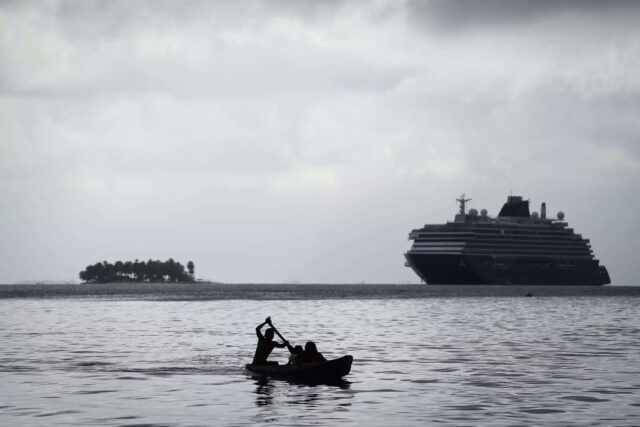
On a recent day, the island’s Indigenous residents rowed or sputtered off with outboard motors to fish. Children, some in uniforms and others in the colorful local textiles called “molas,” chattered as they hustled through the warren of narrow dirt streets on their way to school.
An official with Panama’s ministry of housing said that some people have decided to stay on the island until it’s no longer safe, without revealing a specific number. Authorities won’t force them to leave, the official said on condition of anonymity to discuss the issue.
Gardi Sugdub is one of about 50 populated islands in the archipelago of the Guna Yala territory. It is only about 400 yards (366 meters) long and 150 yards (137 meters) wide. From above, it’s roughly a prickly oval surrounded by dozens of short docks where residents tie up their boats.
Every year, especially when the strong winds whip up the sea in November and December, water fills the streets and enters the homes. Climate change isn’t only leading to a rise in sea levels, but it’s also warming oceans and thereby powering stronger storms.The Gunas have tried to reinforce the island’s edge with rocks, pilings and coral, but seawater keeps coming.The Guna’s autonomous government decided two decades ago that they needed to think about leaving the island, but at that time it was because the island was getting too crowded.
Steven Paton, director of the Smithsonian Institution’s physical monitoring program in Panama, said that the upcoming move “is a direct consequence of climate change through the increase in sea level.”
“The islands on average are only a half-meter above sea level, and as that level rises, sooner or later the Gunas are going to have to abandon all of the islands almost surely by the end of the century or earlier.”
“All of the world’s coasts are being affected by this at different speeds,” Paton said.
Residents of a small coastal community in Mexico moved inland last year after storms continued to take away their homes. Governments are being forced to take action, from the Italian lagoon city of Venice to the coastal communities of New Zealand.
A recent study by Panama’s Environmental Ministry’s Climate Change directorate, with support from universities in Panama and Spain, estimated that by 2050, Panama would lose about 2.01% of its coastal territory to increases in sea levels.
Panama estimates that it will cost about $1.2 billion to relocate the 38,000 or so inhabitants who will face rising sea levels in the short- and medium-term, said Ligia Castro, climate change director for the Environmental Ministry.
FAQs
Q1. Which island will be evacuated?
A1. Gardi Sugdub, an island off Panama’s Caribbean coast, will be evacuated.
Q2. Will Panama lose more land?
A2. A recent study by Panama’s Environmental Ministry’s Climate Change directorate, with support from universities in Panama and Spain, estimated that by 2050, Panama would lose about 2.01 per cent of its coastal territory to increases in sea levels.
Disclaimer Statement: This content is authored by a 3rd party. The views expressed here are that of the respective authors/ entities and do not represent the views of Economic Times (ET). ET does not guarantee, vouch for or endorse any of its contents nor is responsible for them in any manner whatsoever. Please take all steps necessary to ascertain that any information and content provided is correct, updated, and verified. ET hereby disclaims any and all warranties, express or implied, relating to the report and any content therein.









































